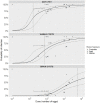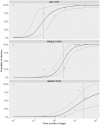Development of a dose-response model for porcine cysticercosis
- PMID: 35286329
- PMCID: PMC8920259
- DOI: 10.1371/journal.pone.0264898
Development of a dose-response model for porcine cysticercosis
Abstract
Taenia solium is an important cause of acquired epilepsy worldwide and remains endemic in Asia, Africa, and Latin America. Transmission of this parasite is still poorly understood despite the design of infection experiments to improve our knowledge of the disease, with estimates for critical epidemiological parameters, such as the probability of human-to-pig infection after exposure to eggs, still lacking. In this paper, a systematic review was carried out and eight pig infection experiments were analyzed to describe the probability of developing cysts. These experiments included different pathways of inoculation: with ingestion of proglottids, eggs, and beetles that ingested eggs, and direct injection of activated oncospheres into the carotid artery. In these experiments, different infective doses were used, and the numbers of viable and degenerated cysts in the body and brain of each pig were registered. Five alternative dose-response models (exponential, logistic, log-logistic, and exact and approximate beta-Poisson) were assessed for their accuracy in describing the observed probabilities of cyst development as a function of the inoculation dose. Dose-response models were developed separately for the presence of three types of cysts (any, viable only, and cysts in the brain) and considered for each of the four inoculation methods ("Proglottids", "Eggs", "Beetles" and "Carotid"). The exact beta-Poisson model best fit the data for the three types of cysts and all relevant exposure pathways. However, observations for some exposure pathways were too scarce to reliably define a dose-response curve with any model. A wide enough range of doses and sufficient sample sizes was only found for the "Eggs" pathway and a merged "Oral" pathway combining the "Proglottids", "Eggs" and "Beetles" pathways. Estimated parameter values from this model suggest that a low infective dose is sufficient to result in a 50% probability for the development of any cyst or for viable cyst infections. Although this is a preliminary model reliant on a limited dataset, the parameters described in this manuscript should contribute to the design of future experimental infections related to T. solium transmission, as well as the parameterization of simulation models of transmission aimed at informing control.
Conflict of interest statement
The authors have declared that no competing interests exist.
Figures



References
-
- Torgerson PR, Devleesschauwer B, Praet N, Speybroeck N, Willingham AL, Kasuga F, et al.. World Health Organization Estimates of the Global and Regional Disease Burden of 11 Foodborne Parasitic Diseases, 2010: A Data Synthesis. PLoS Med. 2015;12(12): e1001920. doi: 10.1371/journal.pmed.1001920 - DOI - PMC - PubMed
Publication types
MeSH terms
Grants and funding
LinkOut - more resources
Full Text Sources

